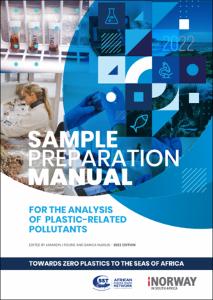| dc.contributor.author | Fourie, Amarein | |
| dc.contributor.editor | Fourie, Amarein | |
| dc.contributor.editor | Marlin, Danica | |
| dc.date.accessioned | 2022-11-16T14:44:38Z | |
| dc.date.available | 2022-11-16T14:44:38Z | |
| dc.date.issued | 2022 | |
| dc.identifier.citation | Fourie, A. and Martin, D. (Eds) 2022 Sample Preparation Manual for the Analysis of Plastic-related Pollutants. Gqeberha, South Africa, African Marine Waste Network, Sustainable Seas Trust, 49pp. DOI: http://dx.doi.org/10.25607/OBP-1854 | en_US |
| dc.identifier.uri | https://repository.oceanbestpractices.org/handle/11329/2096 | |
| dc.identifier.uri | http://dx.doi.org/10.25607/OBP-1854 | |
| dc.description.abstract | The occurrence of plastics in the natural environment has been reported from the most remote
places on earth. As such, there is growing global concern about the potential human health
impacts caused by plastic pollution and an urgency to implement effective actions to mitigate
such pollution. International organisations have, therefore, called for the standardisation of
methods for collecting data on plastic pollution. For example, in March 2019, UNEA noted the
“need for high-quality data and effective monitoring… of marine litter, including plastic litter
and microplastics, …through harmonised methodologies, to enable better and more effective
action.”
Information about microplastic particles in the environment, be it in water, air, sediment, or
organisms, is being collected by many researchers, increasing our knowledge on the subject,
and methods for collecting microplastic particles already exist. A good example is the guidelines
for monitoring and assessing plastic litter and microplastics, written by the Joint Group of
Experts on the Scientific Aspects of Marine Environmental Protection (GESAMP). Information
on emerging contaminants associated with microplastics, such as bisphenols and
benzophenone UV-filters, is also being collected by researchers. However, to the best of my
knowledge, there are no guidelines for the very first step in monitoring emerging contaminants
– that is, the preparation of samples before they get analysed for these plastic-related
contaminants, i.e. pollutants. This manual was, therefore, produced for two reasons. Firstly, to
answer the call to harmonise methods, and secondly, to provide guidelines for preparing
samples to be ready for analysis for emerging contaminants.
This manual is aimed at African researchers with limited resources who may have English as a
second language, if not third or fourth. It is, therefore, purposefully written in as simple
language as possible, with many photographs showing all the steps to prepare samples for
analysis carefully. The methods are set out clearly, in an orderly fashion, so that they can be
followed by researchers who may not be familiar with sample preparation. It is hoped that the
manual will become the standard guideline for researchers to use in their investigations of
plastic-associated pollutants. This will not only improve our understanding of potential human
health impacts resulting from plastic pollution but will also aid in filling the data gap that exists
for this line of research in Africa.
Dr Danica Marlin
Head of Research at Sustainable Seas Trust | en_US |
| dc.description.sponsorship | Ministry of Foreign Affairs, Norway; African Marine Waste Network (AMWN) programme for providing the
operational aspects. | en_US |
| dc.language.iso | en | en_US |
| dc.publisher | African Marine Waste Network, Sustainable Seas Trust | en_US |
| dc.rights | Attribution-NonCommercial-NoDerivatives 4.0 International | * |
| dc.rights.uri | http://creativecommons.org/licenses/by-nc-nd/4.0/ | * |
| dc.subject.other | Pollutants | en_US |
| dc.subject.other | Bivalves | en_US |
| dc.subject.other | Fish | en_US |
| dc.subject.other | Plastic litter | en_US |
| dc.subject.other | Marine debris | en_US |
| dc.title | Sample Preparation Manual for the Analysis of Plastic-related Pollutants. | en_US |
| dc.type | Report | en_US |
| dc.description.status | Published | en_US |
| dc.format.pages | 49pp | en_US |
| dc.contributor.corpauthor | Sustainable Seas Trust | en_US |
| dc.description.refereed | Non Refereed | en_US |
| dc.publisher.place | Gqeberha, South Africa | en_US |
| dc.subject.parameterDiscipline | Anthropogenic contamination | en_US |
| dc.description.currentstatus | Current | en_US |
| dc.description.sdg | 14.1 | en_US |
| dc.description.sdg | 14.a | en_US |
| dc.description.maturitylevel | Concept | en_US |
| dc.description.adoption | Organisational | en_US |
| dc.description.adoption | International | en_US |
| dc.description.ebv | N/A | en_US |
| dc.description.ecv | N/A | en_US |
| dc.description.supportingotherVariables | N/A | en_US |
| dc.description.sensors | N/A | en_US |
| dc.description.methodologyType | Method | en_US |
| obps.endorsementAuthorDeclared.recommendedPractice | Sustainable Seas Trust | |
| obps.contact.contactname | Amarein Fourie | |
| obps.contact.contactemail | amarein@sstafrica.org.za | |
| obps.resourceurl.publisher | https://sst.org.za/wp-content/uploads/2023/09/FourieandMarlin2022SamplePreparationManualfortheAnalysisofPlastic-relatedPollutants.pdf | |
 Repository of community practices in Ocean Research, Applications and Data/Information Management
Repository of community practices in Ocean Research, Applications and Data/Information Management

